What's in bloom in May Wildflowers in our region that bloom in May. June >
What's in bloom in May Wildflowers in our region that bloom in May. Weeds! Click here
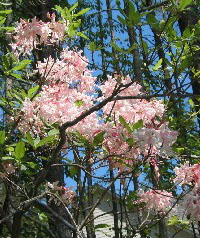
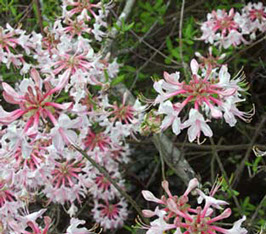
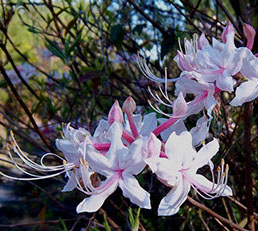
Wild Native Azalea, Rhododendron canadense, Rhododendron pericyclymenoides and others. Perennials native to northeastern North America, From Pennsylvania and New Jersey north to the eastern Canadian provinces. A thinly leaved erect-branch shrub, three to four feet in height. Showy clusters of rosy pink flowers occur in terminal clusters. Its flowers blooms before leaves open. Prefers bogs and wet slopes and woodlands; likes acid soil. Bloom size is an inch or more. Blooms late May well into June.
Bluebells or Virginia Bluebells, Mertensia virginica, is a perennial native to eastern North America from the southern Appalachians to Canada. It comes into bloom just as the first trees sprout leaves, and is usually finished blooming by late April or early May. The one to two foot arching stems have hanging clusters of lavender-blue flowers. Bloom size is one inch.

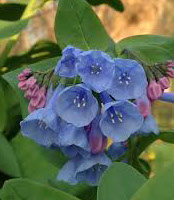

Many April flowers will still be in bloom in early May, so be surt to check the April page too!
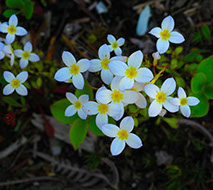

_hedyotis_caerulea.jpg?crc=98150787)
Bluets, Houstonia caerulea, native to eastern North America is a delicate perennial found in compact tufts about eight inches high Tiny flowers, barely a half inch across, are pale blue with yellow centers. Occurs in open fields and woods from April to June.
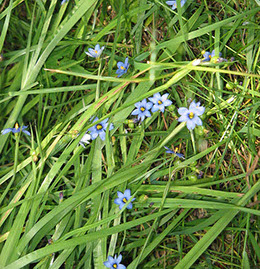

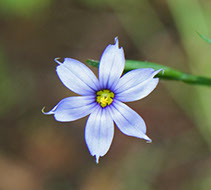
Blue-eyed Grass, Sisyrinchium angustifolium. A perennial native to eastern North America. Actually not a grass, but a member of the iris family. Grows in fields and at woodland verges, and blooms late March through May.
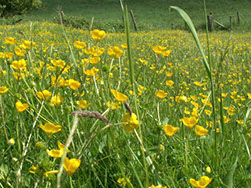
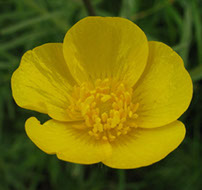
Buttercups, Ranunculus species. Many species of buttercups may found in our area, some native some not. Most bloom spring through fall, some lasting until frost. Sizes vary from about a half-inch to an inch across.

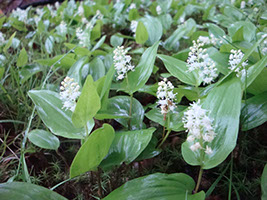

Canadian Mayflower, or False Lily-of-the-valley, Maianthemum canadense, is short perennal plant native to North America from the boreal forests south to Pennsylvania and along the Applachian spine. It has with small, dense clusters of white star-shaped flowers. In bloom, tiny, white flowers are upright in clusters. Has a small, pale red berry. Common forest herb, found in wet, boggy, or mossy areas. Individual flowers are one-eighth inch across. Blooms May to June in our area.


Columbine, Eastern red columbine, Wild red columbine; Aquilegia canadensis, erect perennial, up to 2 foot, with showy red and yellow-centered flowers. Heavy, drooping flowers attract insects and hummingbirds. Bloom size about an inch and a half inch, and they bloom late April into June in our area.
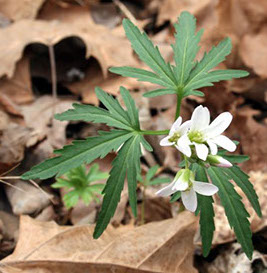
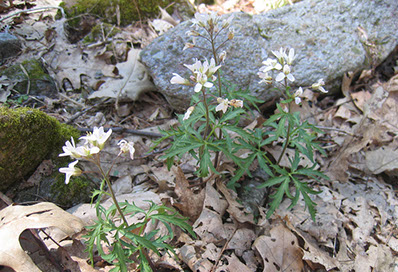
Cutleaf Toothwort, Dentaria laciniata, is a perennial native to North America east of the Rockies. Blooms April and May in our region.
1.jpg?crc=240919899)
3-crop-u19470.jpg?crc=4284324365)
2.jpg?crc=330717236)
Daisy Fleabane, Erigeron annuus. Also Philadelphia fleabane, Erigeron philadelphicus, Both look nearly the same, but the latter plant has leaves that closly clasp the stem. Both bloom May up to frost. They are annuals native to most of North America, with erect stem with spreading hairs that bear flower heads with tightly packed, finely-petaled, white to pink ray flowers around central yellow disk. Bloom size is about a half inch across.


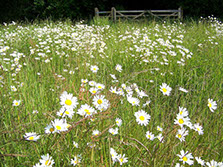
Oxeye Daisy, Leucanthemum vulgare, syn. Chrysanthemum leucanthemum. An annual Eurasian native now found in all US states and Canadian provinces. Common white-and-yellow daisy of the fields, with solitary flowers on slender, erect stems. Flowers are an inch or two across and bloom from late May throughout summer.
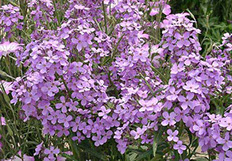
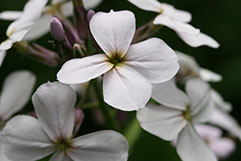
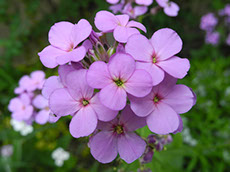
Dame's Rocket, Hesperis matronalis. A Europen native biennial. Flower has four petals, unlike the similar Wild Blue Phlox, which has five. Flowers can be purple, white and all shades in between, even streaked. Upright, multi-branched, growing three foot tall. Grows along roadways, woodland edges, and openings in forest interiors. Invasive, and can displace native plants.
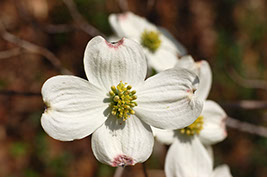
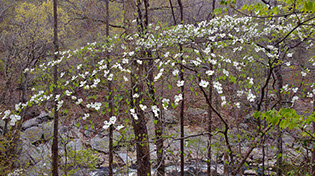

Native Dogwood, Cornus florida. Always white, and not to be confused with imported varieties. The fall fruits of the native tree are an important food for migrating song birds, unlike those of non-native species. The flowers are two to three inches across and bloom late April to early June in our region.
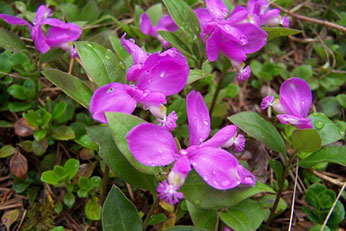
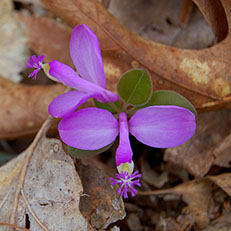
Fringed Polygala or Gaywings, Polygala paucifolia, is native to northeastern and northcentral North America, and along the Appalachian spine. Plants three to six inches high produce orchid-like flowers more than a inch across.
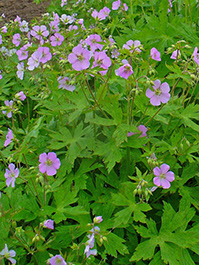

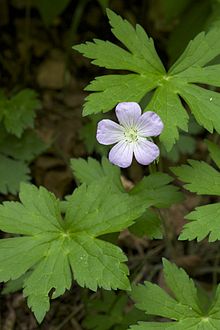
Wild Geranium, Geranium maculatum, native to eastern North America. Five-petaled flowers about an inch acrosss on 1 to 3 foott stem. Semi-evergreen perennial well known for its 5- to 6-parted, deeply cut leaves. Prefers woods, thickets, and meadows. Blooms May into June in our region.
1-crop-u14441.jpg?crc=390019689)
4-crop-u14446.jpg?crc=11700268)
.jpg?crc=4282645095)
Golden Ragwort, Senecio aureus. A perennial evergreen that blooms April through July. Native to eastern North America. The flowers are about a half inch across abd grow on strons stems about 1 to 3 foot tall.
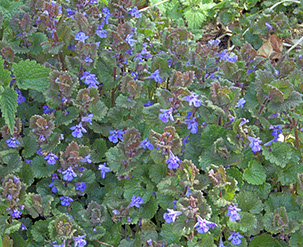

Ground Ivy, Glechoma hederacea, naturalized native of Europe and parts of Asia. Blooms May to July. Tiny flowers, usually a half inch or less across, and lobed leaves. Flowers are often in clusters of two or three. Prefers shaded, moist areas. The plant is toxic when eaten.


Grape Hyacinth, Muscari botryoides, is a perennial native to Europe and found in woods and fields. It blooms in April and May in our region. It is small, and not particularly invasive.
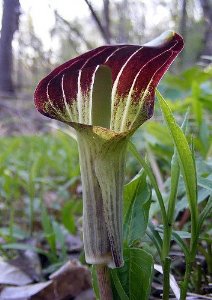
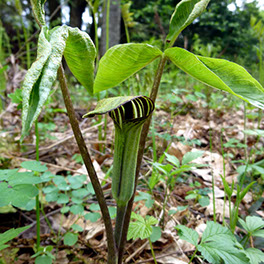
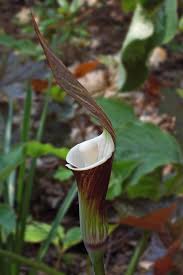
Jack-in-the-pulpit, Arisaema triphyllum, a perennial North American native from Nova Scotia to Minnesota and south to the Gulf coast. It has one to two large, glossy leaves, divided into leaflets and rising on stems 1 to 3 foot tall. The single blossom occurs on a separate stalk at leaf height. Large, cylindrical, hooded flower, green in color with brown stripes. The flower may be up to three inches across and six inches high. In late summer, clusters of red berries appear. Prefers damp woods and swamps.

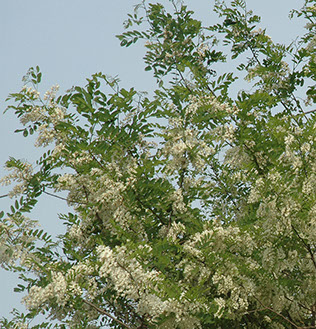
Black Locust or False Acatia, Robinia pseudoacacia, is a perennial tree or shrub native to the southeastern United States, but has been widely planted and naturalized elsewhere in temperate North America. Since it fixes nitrogen, it does well on disturbed soil such as embankments and roadsides. Blooms in May.
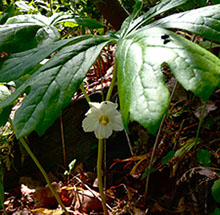
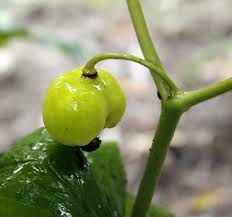

Mayapple, Podophyllum peltatum, Is a perennial native to the eastern half of North America. Colonies sprout from a single root system, while individula plants have only two leaves and one flower growing along the stem. Large twin leaves are showy, 8 inches or more across, with solitary white to rose-colored flower with 6 to 9 waxy petals and many stamens. Has a large, fleshy, lemon-shaped berry. Colonizes damp, open woods. Bloom size is about two inches. Blooms in May. The fruit is edible when ripe, that is, when it is soft and yellow. Unripe fruit is somewhat toxic.
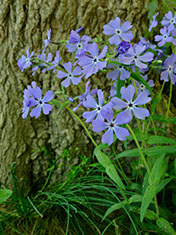


Wild Blue Phlox oe Wild Sweet William, Phlox divaricata, a perennial native to eastern North America. Flower has five petals, while the similar Dame's Rocket has four. Blooms late May into June.

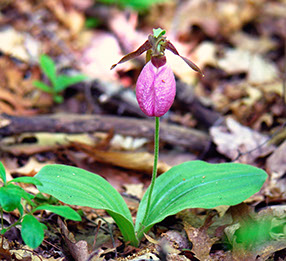
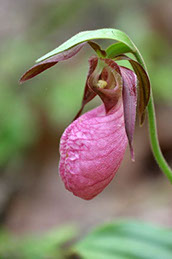
Pink Ladyslipper, Moccasin Flower, Cypripedium acaule. A true orchid, native to eastern US and Canada, found at altitude and north as far as the Arctic Circle, almost always in well-drained woodlands. The largest native orchid, it can be almost three inches long and in our area blooms May into June.
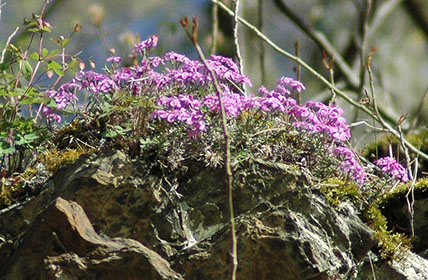

Wild Pink, Silene caroliniana, subspecies pensylvanica, is a perennial native to the northeast US from Virginia to central New England. Blooms April to June. Likes cliff faces and rocks, and is mosty often seen in clumps in nearly accessable locations.
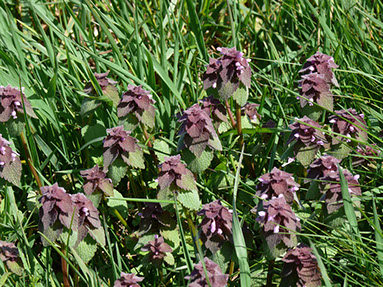
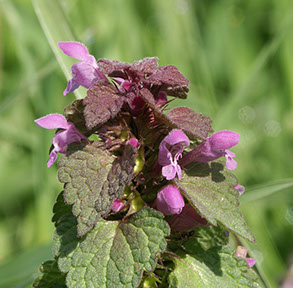
Purple Dead Nettle, Lamium purpureum, a annual Eurasian native now found across most of North America, It grows up to 10 inches high with leaves that have fine hairs, are green at the bottom and shade to purplish at the top. It is not a true nettle and does not sting, hence, dead nettle. This plant can be invasive and weedy. Blooms April through summer.
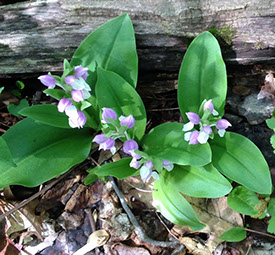
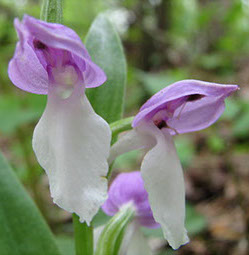
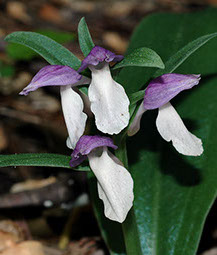
Purple Orchis or Showy Orchis (or orchid), Galearis spectabilis. A wild perennial orchid native to eastern US and Canada. Has a short stalk rising between two large, glossy, green leaves and topped by 2-15 white, pink, lavender flowers. Prefers rich, damp woods and swamps. Bloom size is one inch. Blooms May into June.
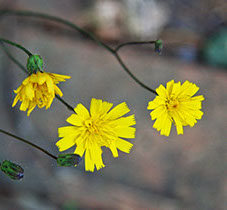
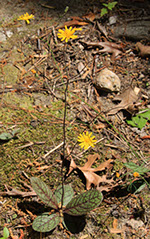

Rattlesnake Weed, Hieracium venosum, a perennial native to eastern North America. Flowers up to an inch across grow on leafless stems that may be as tall as two feet. Blooms late May well into June. The distinctive leaves make this plant easy to identify.


Speedwell, Persian Speedwell, Birdseye Speedwell, Veronica persica, is a seed propagated annual native to Eurasia found throughout North America. Blooms April to August with very tiny flowers less than a quarter inch across.


Spiderwort, Tradescantia virginiana, is a perennial native to the eastern United States, sometimes cultivated in gardens. Its leaves and stalks can grow up to three feet high and the three petal flowers are an inch to two inches across. Blooms mid-May into June.

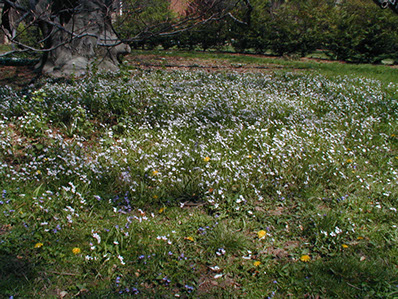
Spring Beauty, Claytonia virginica, a perennial native to eastern North America, blooms April into May in our region. The flower will fade, the seed pods ripen, and the above-ground part of the plant will disappear by early June. The plant overwinters as corms. It can be distinguished from the Carolina Spring Beauty (below) by its narrow grass-like leaves.
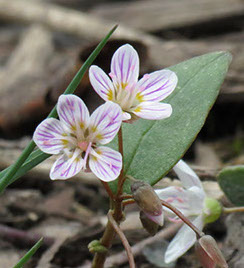

Carolina Spring Beauty, Claytonia caroliniana, a perennial native to eastern North America, blooms April into May in our region. The flower will fade, the seed pods ripen, and the above-ground part of the plant will disappear by early June. The plant overwinters as corms. It can be distinguished from the common Spring Beauty (above) by its broad leaves.

Star of Bethlehem, Ornithogalum umbellatum, is an Old World native that has escaped from gardens and now grows wild across the eastern US. It grows in clumps with hollow, dark-green leaves. Leaves have distinctive white mid-rib and are covered with waxy coating. Easily confused with wild garlic, but lacks distinctive odor. Flowers are bright white with six petals and prominent green stripe on underside. Bloom size is one to two inches across, Blooms late April to mid June.
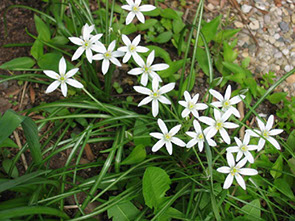
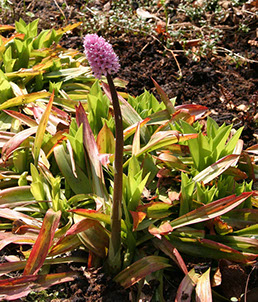
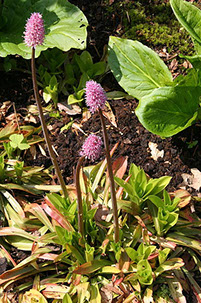
Swamp Pink, Helonias bullata, is native perennial of the lily family. It has smooth, dark green leaves that form an evergreen rosette. Rosettes produce a flowering stalk that can grow over 3 feet tall. It blooms late March through May. An officially threatened species, it is vulnerable to habitat loss due to development and wetland drainage. Half the remaining range of the plant is in southern New Jersey, with some in Delaware and bayshore Maryland and parts of Virginia.
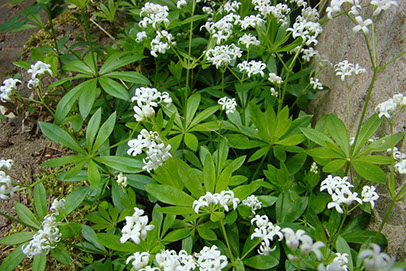
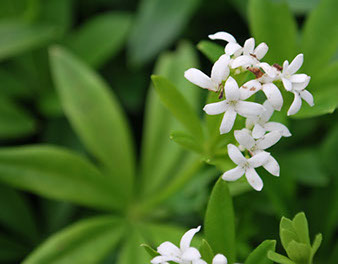
Sweetscented Bedstraw, Galium odoratum, is a flowering perennial plant, native to Eurasia. It is also sparingly naturalized in scattered locations in the United States and Canada. It is widely cultivated for its flowers and its sweet-smelling foliage. If you see it it is likely to be an escaped cultivar. Bloom April through (not yet determined) in our region.

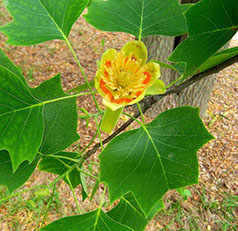
Tulip Poplar, Liriodendron tulipifera. This tall native hardwood tree not only produces straight-grained lumber, it blooms with large, beautiful flowers up to five inches across that many people do not notice until the flowers fall to the ground. Blooms late May into June.
_-_laeken.jpg?crc=3804976774)

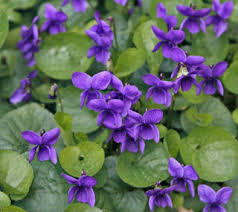
Violets, Viola sororia, synonym Viola papilionacea, is a native of eastern North America that can grow as an annual or as a perennial. Glossy, heart-shaped leaves may grow as tall as six to eight inches, topped with purple flowers with conspicuous white to yellow throats. Erect flower stem droop and produce whitish fruit with great quantities of seeds. Prefers damp woods and moist meadows. Bloom size a hal inch to an inch, they Bloom from April throughout summer. State flower of New Jersey.
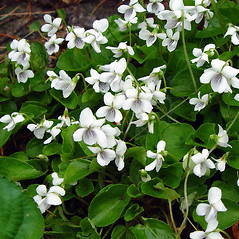

Sweet White Violet, Viola blanda, similar to Viola sororia, but with fragrant white flowers.
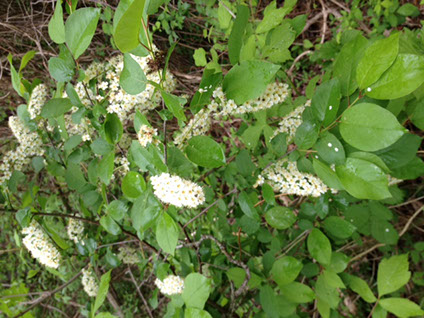
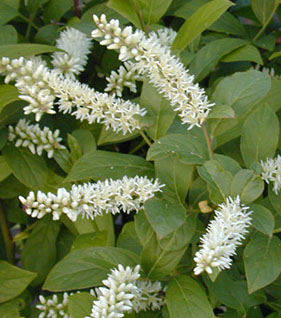
Virginia Sweetspire, Itea virginica, is a perennial shrub native from Pennsylvania and New Jersey south along the Appalachians and the Gulf Coast. It blooms in May in our area, and has bright read leaves in the fall. It may grow five foot tall. It is also cultivated as a garden plant and sold in nurseries.
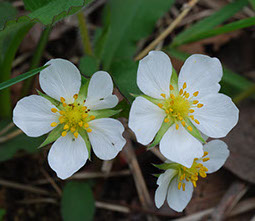
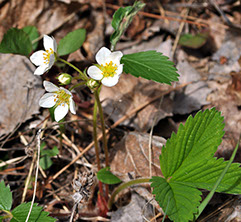
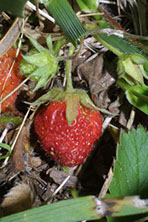
Wild Strawberry, Fragaria virginiana, native to eastern North America. It was hybridized with a species from Chile to produce the domestic strawberry. A low perennial forming runners and several small, white flowers. Bloom size 1 inch, blooms in May and fruits in June in our area. Produces small, sweet, intensly flavored berries.
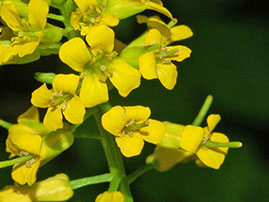

Yellow Rocket or Wintercress, Barbarea vulgaris, a Eurasian native now common across North America. Tufted plant with elongated clusters of small bright yellow flowers atop erect leafy stems. Frequently forms showy yellow patches in open fields. Bloom size about a third of an inch. Blooms April into summer. Originally introduced by early European settlers to provide a scurvy-curing early spring green, the plant is ediable. Very fragrant, and long-lasting as a cut flower.
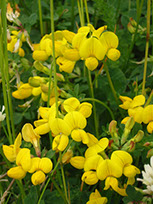
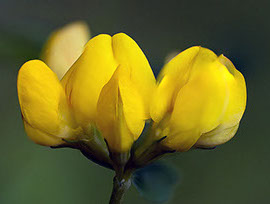
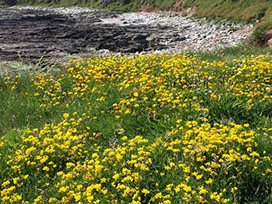
Birdsfoot Trefoil, Lotus corniculatus, Eurasian native widely grown as a forage crop. A pea family member that fixes nitrogen, withstands close grazing and is good for livestock. Blooms late May through summer.
Problem invasive species: Japanese Honeysuckle, or just Honeysuckle, Lonicera japonica
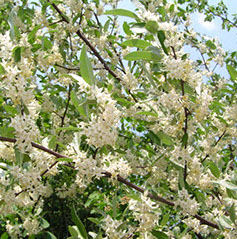
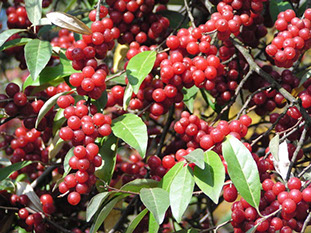
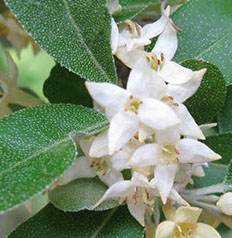
Problem invasive species: Autumn-Olive, Elaeagnus umbellata. Not a true olive. An aggressive invader with powerfully fragrant flowers. Displaces native species. Drought tolerant and thrives in poor soils by fixing nitrogen. Not a true olive, this deciduous shrub grows up to 20 foot tall with stems, buds, and leaves covered in rusty scales. Flowers are pale yellow and pointed at petal tips. Fruits small red-brown to pink and abundant. Prefers grasslands, fields and open woodlands. Bloom size is two to three inches and blooms in May.

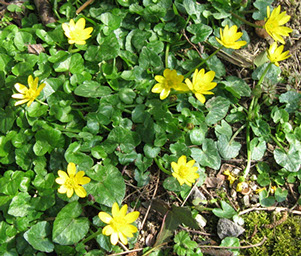
Problem Invasive: Lesser Celandine or Fig Buttercup, Ficaria verna formerly Ranunculus ficaria, Is a vigorous invasive that blooms in the spring, particularly along streams in the floodplain, often sprouting amd blooming before native species. It not only displaces native wildflowers, it provides no food for native pollinators just emerging in spring. Many of these starve to death, and their reduced numbers adversely affect both wild plants and food crops.
This plant, native to Europe, North Aferica and wastern Asia, is easily confused with the native Marsh Marigold. It frequently displaces that plant, Trout Lilies and Bluebells. Click here for more information. Despite the environmental harm this plant does, it is still legally sold as an ornamental in many states.
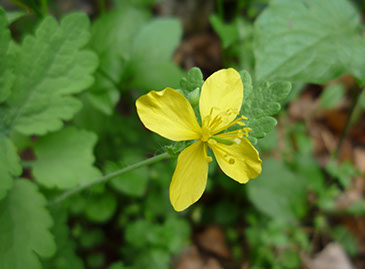
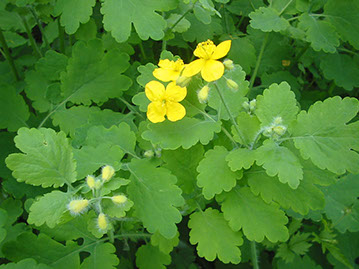
Problem Invasive: Greater Celandine, Chelidonium majus, is a biennial, slightly perennial plant of the poppy family native to Europe and western Asia. It blooms May into June. The plant has been used as a folk remedy for a variety of ailments. It is moderately toxic, ans numerous clinical reports have shown the use of the plant has caused liver damage.
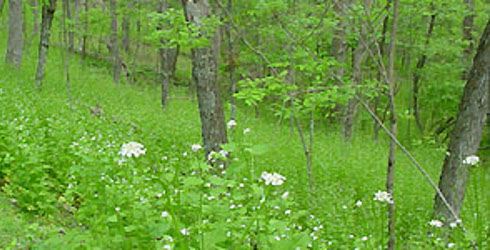
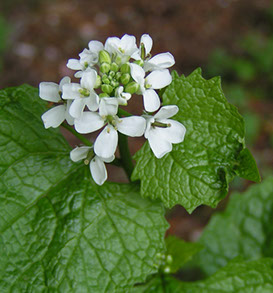
Problem Invasive: Garlic Mustard, Alliaria petiolata, a biennial native to Europe introduced either accidentally as a contaminant or deliberately as a food and medicinal herb in the late 19th century. It can self-pollinate, or be pollinated by insects. All parts of the plant exhibit a strong odor, particularly when crushed. Its weedy growth chokes out native species and thereby reduce food for native herbivors. More info.
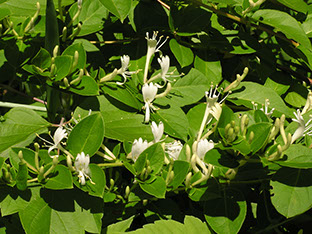
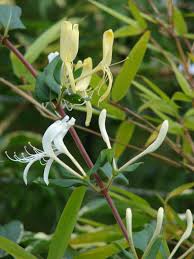
Problem invasive species: Japanese Honeysuckle, or just Honeysuckle, Lonicera japonica. Indigenous to Japan and Korea, it crowds out native vegitation and kills young trees by girdling them. This vine has fragrant, tabular flowers, white to yellow in pairs. Twigs are hairy, leaves evergreen and hairy. Fruit produces a black berry. Prefers thickets, roadsides, and wooded lanes. Bloom size is about an inch and a half long. It has a big flush of flowers in June, then continues blooming but with fewer flowers through summer, more so in sunny locations.
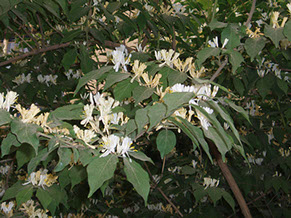
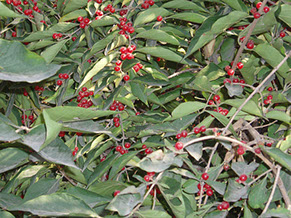
Problem invasive species: Amur Honeysuckle or Phoneysuckle, Lonicera maackii. Indigenous to east Asia. Flowers look like honeysuckle, but have no scent. Plant is a woody deciduous shrub, rather than vines, and can grow 20 foot tall. One of the most common and invasive bush honeysuckles found in mid-Atlantic region. Highly adaptive plant to many conditions. Flowers paired, tubular, white to pinkish. Fruits are red to orange berries produced in late summer and persist through winter. A pest here; an endangered species in Japan.
This is a quick guide to some of wildflowers you might see in bloom in our region in May. Do a web search on each plant for larger photos and detailed information. Spring blooming happens latter in the north and at higher altitude.
If you know of a flowering wild plant that is missing, contact webkeeper@amcdv.org. All photos are in the commons for non-commercial use, as is the information on this page.

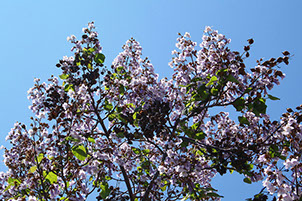
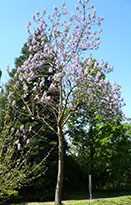
Problem invasive species: Princess tree, Paulownia tomentosa Chinese invasive that populates disturbed woods, stream banks and steep slopes. Blooms early to mid-May before the leaves appear. This deciduous tree can grow to 60 feet tall, with large, fragrant blossoms borne in upright clusters six to 12 inches long. Flowers are purple to white and tubular. Fruits are brown, woody, beaked capsules 1.5 inches long. Bloom size is one to three inches, and it blooms in latein April to May.
